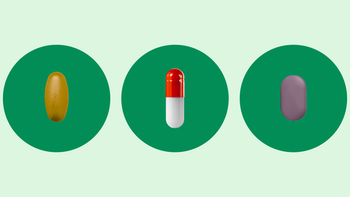
What Happens When You Take Prednisone? Common Side Effects and Tips to Avoid Them
Key takeaways:
Prednisone has many side effects. You’re more likely to experience these side effects with higher doses and longer courses of treatment.
Some side effects like nausea or upset stomach start within minutes of taking prednisone, and mood changes can happen within hours. Other side effects can take days to weeks to develop.
Common short-term side effects include changes in appetite, mood, energy, and sleep. Long-term prednisone treatment can lead to weight gain, osteoporosis, and cataracts.
Diarrhea isn’t a side effect of prednisone. But other gastrointestinal symptoms are possible, like increased appetite and indigestion.
Access savings on related medications
Table of contents
Prednisone is a common prescription medication. It’s a powerful anti-inflammatory medication with uses for a wide range of conditions — from asthma and allergies to lupus and arthritis. But its effectiveness can also take a toll on your body.
Most people who start a course of steroids will notice how it makes them feel different in a variety of ways. You can expect the earliest prednisone side effects to start less than an hour after taking your first dose. But more systemic side effects may take days or weeks to develop.
Let’s take a closer look at the potential side effects of prednisone so you know what to expect — and the best ways to avoid any health risks.
Search and compare options
What is prednisone?
Prednisone is a glucocorticoid, which is a type of steroid hormone. This means it affects many different body processes. It changes how your brain processes information, how your body burns carbohydrates, and the way your immune system fights infection — to name a few.
Prednisone is most often used to lower inflammation in the body. Some people only need to take prednisone for a few days or weeks — like when they have an allergic reaction. Other people take prednisone every day as part of their regular medications — like for an autoimmune disorder. The side effects of prednisone depend on the dose and how long you take it.
Short-term side effects of prednisone
Many people only need a short course of prednisone (1 to 2 weeks) to treat their condition. And this is good because most side effects of prednisone are “dose dependent.” This means the risk of side effects increases with higher doses and longer courses of steroids. This also means that most of these side effects will be temporary and go away after you stop taking it.
If you’ve been prescribed prednisone for a short period of time, here are some common side effects you may experience.
Appetite changes
Most people notice an increase in their appetite while taking prednisone. Prednisone looks like a stress hormone (cortisol) to the brain. Because of this, prednisone can act directly on the brain to stimulate appetite.
Prednisone can also sometimes cause nausea and indigestion. These symptoms often resolve with eating, prompting people to eat more than usual. Prednisone also seems to make people crave more calorie-dense foods, which can result in weight gain.
Indigestion
Prednisone can lead to stomach irritation for some people. This can happen pretty quickly — often within minutes of taking prednisone. This is much more likely to happen if you’re also taking nonsteroidal anti-inflammatory drugs (NSAIDs) at the same time. Other digestive changes, like diarrhea, are not common side effects of prednisone (more on this below).
High blood sugar
Prednisone affects insulin levels and insulin resistance. This can cause increased blood sugar, even with low doses. This is especially a risk for people with diabetes or prediabetes. People with known diabetes should monitor their blood sugar levels with a glucose monitor while on prednisone, especially if they’re taking them for a long period.
Fluid retention
When taking prednisone, you may notice that your face, hands, or feet feel a little puffier than normal. And this may lead to temporary weight gain for some people. This swelling (edema) is more likely to be a problem for people with heart failure or kidney disease. People with known heart and kidney conditions should monitor their blood pressure and keep an eye out for symptoms of fluid retention.
What does taking prednisone feel like? Hear from, three people about the side effects they’ve experienced while taking prednisone and how the medication has improved their inflammatory conditions.
How much does prednisone cost? Learn more about what you can expect to pay and find savings tips to help you afford prednisone.
Drug interactions: Prednisone can interact with several common daily medications. Find out if you might need a dosage change or another adjustment to your medications before taking prednisone.
Sweating and hot flashes
You may feel warmer or sweat more than normal with prednisone. And some people have full-on hot flashes while taking it. People taking higher doses of prednisone are more likely to experience side effects like sweating or hot flashes. You can try to avoid triggers like caffeine, alcohol, and spicy foods if you experience excessive sweating while on prednisone.
Mood changes
People report a wide variety of changes in their mood while taking steroids. Mood changes can happen within a few hours of taking a prednisone dose. Some people experience an improved mood, while others feel more depressed. Mood changes are common, too.
In rare cases, people experience disorientation and hallucinations — a condition called “steroid-induced psychosis.” This is more likely if you’re taking high doses of prednisone for a longer period of time.
Restlessness
In addition to mood changes, prednisone can increase energy levels. Some people may not mind this side effect, but others may feel unpleasantly jittery. It can also make you feel like it’s harder to concentrate.
Sleep disturbance
Prednisone keeps some people awake. This is because it affects the hormones that help you feel energized (cortisol) and sleepy (melatonin). So it’s common for people to report difficulty sleeping while they’re taking prednisone. This is more likely when someone has to take several doses of medication throughout the day — including one at night.
Does prednisone cause diarrhea?
Diarrhea isn’t a side effect you need to worry about with prednisone. If you have new diarrhea and you’re taking prednisone, something other than the medication is likely the cause.
In rare cases, gastric irritation from prednisone can cause a bleed in the stomach. This is much more likely to happen if you’re taking NSAIDs at the same time. This can show up either as a "coffee-ground" vomit or as black, tarry stool. Either way, this is a medical emergency.
Are prednisone side effects in women different from the side effects in men?
It’s generally believed that prednisone has similar side effects in both women and men. But one small study showed that women are more likely than men to experience certain side effects.
In this survey, women were about 10% more likely to experience these side effects:
Weight gain
Changed appearance
Moon face
Depression
Fatigue
Mood changes
Hair loss
Sleeplessness
Stomach complaints
Long-term side effects of prednisone
People who take prednisone for chronic conditions often take it for months to years. This puts them at a risk for long-term side effects that aren’t an issue if you only take prednisone for a couple of weeks.
Let’s take a closer look at some of the long-term side effects of prednisone.
Weight gain
Weight gain can be an issue with long-term steroid use. Experts think long-term weight gain from steroids comes from the increased appetite, changes in sugar and fat metabolism, and fluid retention.
Steroids like prednisone also cause a change in where fat is deposited in the body. People on steroids long-term might notice more fat across their shoulders, in their face, and around their belly.
Osteoporosis
Osteoporosis is a well-known and potentially serious side effect of long-term steroid use. And decreased bone density can occur within weeks of starting treatment. This side effect significantly increases the risk of fracturing a bone in people who take prednisone. The risk is greater the longer a person is on prednisone and the higher the dose.
Cataracts and glaucoma
Cataracts and glaucoma are eye conditions that are more likely in people who use steroid eye drops. But they can still happen in people who take oral prednisone long term. This risk increases in people taking more than 10 mg of prednisone a day for over 1 year.
High blood pressure and heart disease
There has been a lot of research into whether long-term use of prednisone can cause high blood pressure or heart disease. And some evidence suggests there’s a risk. But it’s more likely to happen when someone is taking high doses or prednisone for a long period of time.
High blood pressure from steroid use is likely due to several factors. These include fluid retention, weight gain, and the direct effect of steroids on receptors throughout the body.
Weakened immune system
Many people take prednisone to weaken their immune system and treat certain conditions. But it’s important to know that prednisone can increase your risk of bacterial, viral, and fungal infections as a result. This risk likely increases with higher doses of prednisone. It’s also affected by any underlying conditions that may also affect immune function.
How can I reduce the risk of long-term prednisone complications?
If you have a medical condition that requires long-term prednisone use, there are some things you can do to decrease your risk of complications:
Talk with your healthcare professional about ways you can stay on the lowest dose possible. The risk of most of these side effects increases with higher doses.
Be sure to schedule a checkup with your regular healthcare professional at least once a year. They can check you for signs of high blood pressure or diabetes.
If you have diabetes or prediabetes, check your blood sugar every day. Talk with your healthcare professional if you notice your blood sugar is higher than normal.
If you have high blood pressure, check your blood pressure every day. Talk with your healthcare professional if you notice your blood pressure is higher than normal.
Get a bone scan to check for signs of osteoporosis.
Schedule yearly checkups with an ophthalmologist to keep your eyes healthy.
Tips to avoid prednisone side effects
Prednisone can make you feel different than normal. But there are steps you can take to decrease the risk of unwanted side effects.
Things to avoid (or cut back on) while taking prednisone include:
Caffeine: Combining caffeine with prednisone can keep you awake at night or make you feel jittery and anxious.
Alcohol: Alcohol can worsen mood changes prednisone causes and also affects your sleep quality.
Sugary foods: Because prednisone can cause high blood sugar levels, try to cut back on meals and snacks high in sugar or carbohydrates.
Salty foods: Foods that are high in salt can worsen fluid retention and lead to swelling in your legs, hands, and face. Consider following the DASH diet while taking prednisone.
Prednisone at bedtime: If possible, take your prednisone first thing in the morning. Prednisone doses at bedtime can keep you awake and worsen sleep side effects.
Serious prednisone side effects: What to do if you feel unwell
It can be unsettling when your body feels out of balance or you feel different than your normal self. So be easy on yourself. Allow yourself time to rest and recover. And reach out to your medical professional for help if you have or feel:
High blood sugar levels, especially if you have diabetes or are at risk for diabetes
High blood pressure readings at home, or you’re experiencing symptoms of high blood pressure
New swelling in your legs, chest pain, or difficulty breathing
Any changes in your vision
Significant pain in your stomach, vomiting, or black stools
Confusion, disorientation, or hallucinations
Depression or significant drops in your mood
If you’re having thoughts of self-harm or suicide, call the National Suicide Prevention Lifeline (1-800-273-8255) or dial 988 from anywhere in the U.S.
The bottom line
Prednisone is a strong and effective medication. But it can affect the body in many different ways, and this means it comes with a lot of side effects. If you’re taking prednisone for a short period of time, there are some simple steps you can take to keep yourself feeling healthy and balanced. And rest assured, you’ll get back to feeling like your normal self once you complete your treatment course.
If you’re taking prednisone for more than a couple of weeks, work with your healthcare professional. They can help make sure you’re taking the right steps to decrease your risk of any unwanted side effects.
Why trust our experts?



References
Climan, A. (2023). Sweating from prednisone: 5 tips to reduce this side effect. MyCrohnsAndColitisTeam.
Da Silva, J. A. P., et al. (2006). Safety of low dose glucocorticoid treatment in rheumatoid arthritis: Published evidence and prospective trial data. Annals of Rheumatic Diseases.
Dubovsky, A. N., et al. (2012). The neuropsychiatric complications of glucocorticoid use: Steroid psychosis revisited. Psychosomatics.
Lee, I., et al. (2018). Gender differences in prednisone adverse effects: Survey result from the MG registry. Neurology Neuroimmunology & Neuroinflammation.
Liu, D., et al., et al. (2013). A practical guide to the monitoring and management of the complications of systemic corticosteroid therapy. Allergy, Asthma, & Clinical Immunology.
McKay, L. I., et al. (2003). Physiologic and pharmacologic effects of corticosteroids. Holland-Frei Cancer Medicine, 6th edition.
Mebrahtu, T. F., et al. (2020). Oral glucocorticoids and incidence of hypertension in people with chronic inflammatory diseases: A population-based cohort study. Canadian Medical Association Journal.
Migita, K., et al. (2013). Rates of serious intracellular infections in autoimmune disease patients receiving initial glucocorticoid therapy. PLoS One.
National Health Service. (2022). Side effects of prednisolone tablets and liquid.
Verhaegen, A. A., et al. (2019). Drugs that affect body weight, body fat distribution, and metabolism. Endotext.
Waljee, A. K., et al. (2017). Short term use of oral corticosteroids and related harms among adults in the United States: Population based cohort study. The British Medical Journal.
Was this page helpful?
Related Articles
Browse medications
View AllResearch prescriptions and over-the-counter medications from A to Z, compare drug prices, and start saving.




























